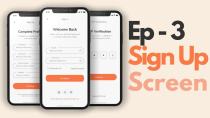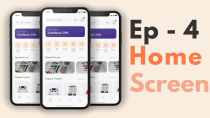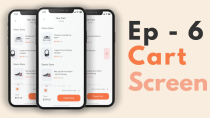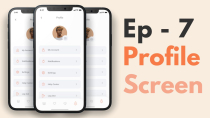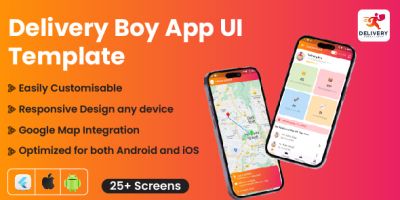Flutter-UI kit Ecommerce App Flutter-UI kit Ecommerce App
A Flutter-UI kit for an eCommerce app is a comprehensive toolkit designed to facilitate the rapid development ..Flutter-UI kit Ecommerce App
A Flutter-UI kit for an eCommerce app is a comprehensive toolkit designed to facilitate the rapid...
Overview
A Flutter-UI kit for an eCommerce app is a comprehensive toolkit designed to facilitate the rapid development of visually appealing and highly functional eCommerce applications. Built using Flutter, Google's UI toolkit for building natively compiled applications for mobile, web, and desktop from a single codebase, this UI kit provides developers with pre-designed templates, components, and widgets tailored specifically for eCommerce functionalities. These include product listings, shopping carts, payment gateways, user profiles, and more, all designed with a consistent aesthetic and responsive layout that ensures a seamless user experience across different devices and screen sizes.
By leveraging a Flutter-UI kit, developers can significantly reduce the time and effort required to create an eCommerce app from scratch. The kit includes reusable code snippets and modular components that can be easily customized to fit the specific needs of any online store. This not only accelerates the development process but also ensures that the app maintains a high level of performance and reliability. Furthermore, the cross-platform nature of Flutter means that the same codebase can be used to deploy the app on both iOS and Android, ensuring a consistent user experience and reducing maintenance overhead. Overall, a Flutter-UI kit for eCommerce apps empowers developers to deliver professional-grade, feature-rich shopping experiences with efficiency and ease.
Features
Features of a Flutter-UI Kit for an E-Commerce App
- Pre-designed Templates:
- Ready-to-use templates for homepages, product pages, and checkout pages.
- Consistent design themes that ensure a professional and cohesive look.
- Responsive Layout:
- Adaptive designs that work seamlessly on various screen sizes and devices.
- Ensures optimal user experience on both mobile and tablet devices.
- Product Listings:
- Grid and list view options for displaying products.
- Detailed product pages with images, descriptions, pricing, and reviews.
- Shopping Cart:
- Easy-to-use shopping cart interface with add, remove, and update functionalities.
- Real-time cart updates and synchronization.
- User Authentication:
- Built-in support for user registration, login, and password recovery.
- Social media login integration (e.g., Google, Facebook).
- Payment Gateway Integration:
- Secure payment processing with support for multiple payment methods.
- Integration with popular payment gateways like PayPal, Stripe, and Razorpay.
- Search and Filter:
- Advanced search functionality to help users find products quickly.
- Filters for categories, price ranges, ratings, and more.
- User Profiles:
- Personal profile management with order history and saved addresses.
- Wishlists and favorites for saving desired products.
- Push Notifications:
- Support for push notifications to alert users about new products, offers, and order updates.
- Customizable notification templates.
- Review and Ratings:
- Users can leave reviews and ratings for products.
- Display average ratings and user feedback on product pages.
- Admin Panel Integration:
- Backend support for managing products, orders, and users.
- Analytics and reporting tools to track sales and performance.
- Localization and Multi-language Support:
- Easily customizable to support multiple languages.
- Adaptable to different currencies and regional settings.
- Animations and Transitions:
- Smooth animations and transitions for a polished user experience.
- Interactive elements that enhance user engagement.
- Customization Options:
- Highly customizable UI components to match brand aesthetics.
- Flexible theming and styling options.
- Security Features:
- Secure data handling and storage.
- Protection against common vulnerabilities such as XSS and CSRF attacks.
These features make a Flutter-UI kit for eCommerce apps a powerful tool for developers, enabling them to create rich, user-friendly shopping experiences quickly and efficiently.
Requirements
To effectively use a Flutter-UI kit for an eCommerce app, certain requirements must be met both in terms of the development environment and the necessary technical skills. Here are the key requirements:
Development Environment Requirements
- Flutter SDK:
- Install the latest version of the Android Studio, Visual Studio Code, or IntelliJ IDEA that supports Flutter development.
- Install Flutter and Dart plugins in your chosen IDE for enhanced development support.
- Emulator or Physical Device:
- Set up an Android emulator or iOS simulator, or use a physical device to test your application.
- Ensure that your devices have the latest operating system versions that are compatible with Flutter.
- Command Line Tools:
- Command line tools like Git for version control.
- Node.js and npm (Node Package Manager) for managing dependencies if needed.
Technical Skills and Knowledge
- Programming Languages:
- Proficiency in Dart programming language, which is used for Flutter development.
- Basic understanding of JavaScript may be beneficial for certain integrations.
- Flutter Framework:
- Familiarity with Flutter framework, including widgets, state management, and navigation.
- Understanding of Flutter’s widget tree and how to compose complex UIs.
- Front-End Development:
- Knowledge of front-end development concepts including responsive design, layout structures, and animations.
- Experience with UI/UX design principles to create visually appealing interfaces.
- Back-End Integration:
- Ability to integrate the app with back-end services and APIs for data fetching and user authentication.
- Knowledge of RESTful APIs and GraphQL may be required depending on the backend services used.
- Version Control Systems:
- Proficiency in using Git and GitHub for version control and collaborative development.
- Understanding of branching, merging, and pull requests for efficient project management.
- Database Management:
- Experience with local databases like SQLite or Hive for storing app data.
- Understanding of cloud databases and services such as Firebase or AWS for real-time data synchronization.
- Mobile Development Basics:
- Familiarity with the basics of mobile development, including managing different screen sizes, handling app lifecycle, and optimizing performance.
- Knowledge of platform-specific considerations for iOS and Android.
- Testing and Debugging:
- Skills in writing unit tests, widget tests, and integration tests to ensure app reliability.
- Proficiency in using debugging tools to troubleshoot and resolve issues.
Additional Tools and Libraries
- UI Kit Package:
- Download and integrate the specific Flutter-UI kit package you plan to use for your eCommerce app.
- Follow the documentation provided with the UI kit for setup and customization instructions.
- Use third-party plugins from the pub.dev repository for additional functionalities like payment gateways, push notifications, and analytics.
- Design Tools:
- Basic knowledge of design tools like Adobe XD, Figma, or Sketch for understanding design files and implementing UI components accordingly.
Meeting these requirements ensures that you have a smooth development process and can fully leverage the capabilities of a Flutter-UI kit to build a robust and feature-rich eCommerce app.
Instructions
Here are step-by-step instructions for using a Flutter-UI kit to develop an eCommerce app:
Step 1: Set Up Development Environment
- Install Flutter SDK: Download and install the latest version of the Flutter SDK from the official Flutter website.
- Install IDE: Choose an integrated development environment (IDE) such as Android Studio, Visual Studio Code, or IntelliJ IDEA. Install the Flutter and Dart plugins for your chosen IDE.
- Set Up Emulator/Device: Set up an Android emulator, iOS simulator, or connect a physical device for testing your app.
Step 2: Choose a Flutter-UI Kit
- Research: Explore different Flutter-UI kits available online. Consider factors like design, features, and compatibility with your project requirements.
- Download Kit: Once you've selected a suitable Flutter-UI kit, download it from the source provided by the developer.
Step 3: Initialize Flutter Project
- Create New Project: Use the Flutter CLI or IDE to create a new Flutter project.
- Integrate UI Kit: Copy the files from the downloaded Flutter-UI kit into your project directory, following any installation instructions provided by the kit's documentation.
Step 4: Customize UI and Features
- Modify Assets: Replace placeholder images and icons with your own assets. Update any branding elements to match your brand identity.
- Customize Components: Customize UI components and layouts as needed to align with your app's design and functionality requirements.
Step 5: Implement Features
- Product Listings: Implement screens for displaying product listings, including grid or list views with product details.
- Shopping Cart: Create a shopping cart functionality where users can add products, update quantities, and proceed to checkout.
- User Authentication: Integrate user authentication features such as login, registration, and password recovery.
- Payment Gateway Integration: Integrate a payment gateway to enable secure online transactions.
- Search and Filters: Implement search functionality and filters to help users find products easily.
- User Profiles: Develop user profiles where users can view order history, manage addresses, and update account information.
Step 6: Testing and Debugging
- Test on Emulator/Device: Test your app on an emulator or physical device to ensure proper functionality and responsiveness.
- Debugging: Use debugging tools to identify and fix any issues or errors in your code.
Step 7: Deployment
- Build APK/IPA: Build the APK (Android) or IPA (iOS) file for your app using the Flutter CLI or IDE.
- Release to App Stores: Publish your app to the Google Play Store (Android) and/or Apple App Store (iOS) following the respective publishing guidelines.
Following these instructions will guide you through the process of using a Flutter-UI kit to develop an eCommerce app, from setup to deployment. Make sure to refer to the documentation provided with the UI kit for any specific instructions or guidelines.
Other items by this author
| Category | App Templates / Flutter / UI Kits |
| First release | 3 June 2024 |
| Last update | 3 June 2024 |
| Operating Systems | Android 8.0, Android 9.0, Android 12.0, Android 4.0 |
| Files included | .php, .html, .apk, .xml, Javascript .js |
| Tags | ecommerce, responsive, payment gateway, design, shopping cart, mobile app, UI KIT, user interface, flutter, cross-platform, user experience, product listings, app development, front-end, back-end |




